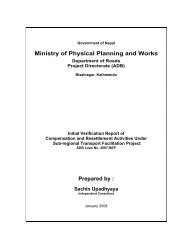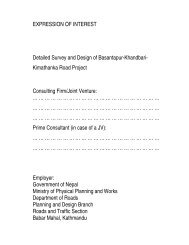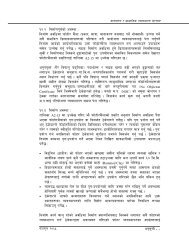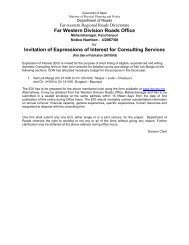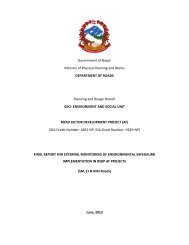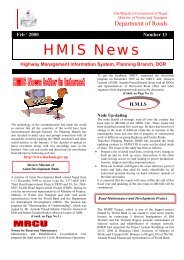Environmental & Social Management Framework - About ...
Environmental & Social Management Framework - About ...
Environmental & Social Management Framework - About ...
Create successful ePaper yourself
Turn your PDF publications into a flip-book with our unique Google optimized e-Paper software.
<strong>Environmental</strong> and <strong>Social</strong> <strong>Management</strong> <strong>Framework</strong>(6) Conduct Public Consultation and Disclose NoticeMost of the international donor agencies financing road development programsput emphasis on a thorough consideration of the vision and comments of all kindof stakeholders related to the project. The EA team therefore needs to identify thespectrum of stakeholders potentially affected by in the planned activities, and todevise mechanisms for public hearings and meetings.The EIA should consider the broad public’s perspective and include them in theassessment process. In particular, suggestions forwarded by the stakeholdersconsulted should be incorporated to the extent possible into the environmentaland social management planning. It is recommended in this framework tocompile the obtained information in a tabular form, indicating date ofconsultation(s), location, number of participants (male(female), issues raised bythe consulted stakeholders and measures to be followed up in the environmentalmanagement planning. It is essential that the EMAP reflects the perceptions,concerns and suggestions as much as they are feasible, credible and sitespecific.The agenda and the result of the public consultation activities carried out undereach EIA/SIA needs to be well documented and made public for receivingcomments. In accord to the EPR regulations, the duration of the public notice is15 days. Received comments need to be incorporated in the project’s design andmanagement plan (see below).(7) Identification of Suitable <strong>Management</strong> and Mitigation MeasuresThe principles adopted for this ESMF are that all proposed mitigation measuresare designed to recommended actions that reduce, avoid or offset the potentialadverse environmental consequences of the proposed project activities. Theproposed actions must be feasible, credible, manageable and cost-effective. Afundamental requirement is that all proposed mitigation would lead to moreenvironmental and social sustainability.The approaches for mitigation measures are ruled by the followingconsiderations:(i)(ii)(iii)(iv)Seek alternatives to avoid particular impacts: Consider alternatives to aproposed project activity, and examine alternative ways to achieve theobjectives to maximize benefits and minimize undesirable impacts.Arrange compensation where particular impacts are unavoidable : Restoredamaged resources, such as, water source, irrigation system, forest.Proper rehabilitation scheme, such as, skills training, new employment.Adequate compensation payments to affected persons for damage or lossof property, livelihood and provision of rehabilitation measures.Take Corrective Measures to reduce unavoidable effects: Considercorrective measures to reduce adverse impacts to acceptable standards,such as, remove, store and reuse top soil material during construction, usespoil material to reclaim low and degraded land, replace or relocatecommunity water source, assist in school expansion to handle influx oflaborers' children, and others.Implement Preventive Measures to avoid some impacts altogether. Prepreparationfor minimizing adverse impacts, such as, implement healtheducation program, initiate public awareness programs.April 2007 Chapter 2-19



![j:6 ]zg cfof ]hgf](https://img.yumpu.com/51286794/1/190x245/j6-zg-cfof-hgf.jpg?quality=85)

![x'nfsL /fhdfu { cfof ]hgf](https://img.yumpu.com/50581959/1/190x245/xnfsl-fhdfu-cfof-hgf.jpg?quality=85)
